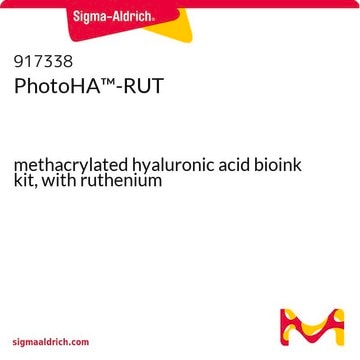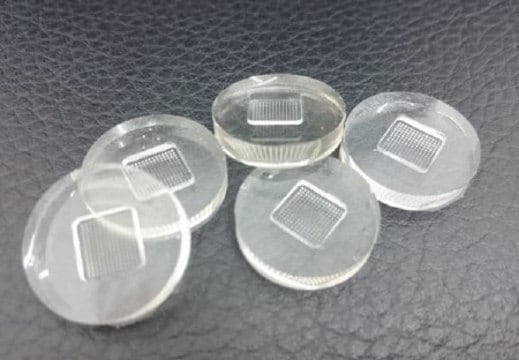おすすめの製品
アプリケーション
Ruthenium is a photoinitiator that utilizes visible light photocrosslinking (400-450nm) to covalently crosslink free tyrosine and acryl groups. Ruthenium photoinitiator has been tested on collagen type I, gelatin, silk fibroin, methacrylated hyaluronic acid, methacrylated gelatin, methacrylated collagen type I and PEGDA. Ruthenium is water soluble and yields better cytocompatibility, and crosslinking efficiency. Ruthenium is red/yellow/orange in color and will change the color of your solutions, hydrogels, or printed constructs. The Ruthenium photoinitiator kit is non-sterile. Adding antibiotics to your cell culture system, or sterile filtering is recommended. To sterile filter, resuspend the entire volume of ruthenium and Sodium persulfate (separately) and filter through small 0.2 micron button filters (separately). Use the sterile photoinitiator within 2 weeks. Ruthenium photoinitiator kit is ideal for tissue engineering, cell culture, and bioprinting, where tuning the mechanical properties of the substrate is required. The kit provides enough photoinitiator for >200 mL of bioinks/hydrogels.
シグナルワード
Danger
危険有害性の分類
Acute Tox. 4 Oral - Ox. Sol. 3 - Resp. Sens. 1 - Skin Irrit. 2 - Skin Sens. 1 - STOT SE 3
ターゲットの組織
Respiratory system
保管分類コード
5.1B - Oxidizing hazardous materials
適用法令
試験研究用途を考慮した関連法令を主に挙げております。化学物質以外については、一部の情報のみ提供しています。 製品を安全かつ合法的に使用することは、使用者の義務です。最新情報により修正される場合があります。WEBの反映には時間を要することがあるため、適宜SDSをご参照ください。
毒物及び劇物取締法
キットコンポーネントの情報を参照してください
PRTR
キットコンポーネントの情報を参照してください
消防法
キットコンポーネントの情報を参照してください
労働安全衛生法名称等を表示すべき危険物及び有害物
キットコンポーネントの情報を参照してください
労働安全衛生法名称等を通知すべき危険物及び有害物
キットコンポーネントの情報を参照してください
カルタヘナ法
キットコンポーネントの情報を参照してください
Jan Code
キットコンポーネントの情報を参照してください
試験成績書(COA)
製品のロット番号・バッチ番号を入力して、試験成績書(COA) を検索できます。ロット番号・バッチ番号は、製品ラベルに「Lot」または「Batch」に続いて記載されています。
J D Parker et al.
The bone & joint journal, 100-B(3), 404-412 (2018-03-29)
The intra-articular administration of tranexamic acid (TXA) has been shown to be effective in reducing blood loss in unicompartmental knee arthroplasty and anterior cruciate reconstruction. The effects on human articular cartilage, however, remains unknown. Our aim, in this study, was
Automated 3D bioassembly of micro-tissues for biofabrication of hybrid tissue engineered constructs.
N V Mekhileri et al.
Biofabrication, 10(2), 024103-024103 (2017-12-05)
Bottom-up biofabrication approaches combining micro-tissue fabrication techniques with extrusion-based 3D printing of thermoplastic polymer scaffolds are emerging strategies in tissue engineering. These biofabrication strategies support native self-assembly mechanisms observed in developmental stages of tissue or organoid growth as well as
J Parrish et al.
Lab on a chip, 18(18), 2757-2775 (2018-08-18)
Traditional 2D monolayer cell cultures and submillimeter 3D tissue construct cultures used widely in tissue engineering are limited in their ability to extrapolate experimental data to predict in vivo responses due to their simplistic organization and lack of stimuli. The
Sarah Bertlein et al.
Advanced materials (Deerfield Beach, Fla.), 29(44) (2017-10-19)
Bioprinting can be defined as the art of combining materials and cells to fabricate designed, hierarchical 3D hybrid constructs. Suitable materials, so called bioinks, have to comply with challenging rheological processing demands and rapidly form a stable hydrogel postprinting in
Khoon S Lim et al.
Biofabrication, 10(3), 034101-034101 (2018-04-26)
Lithography-based three-dimensional (3D) printing technologies allow high spatial resolution that exceeds that of typical extrusion-based bioprinting approaches, allowing to better mimic the complex architecture of biological tissues. Additionally, lithographic printing via digital light processing (DLP) enables fabrication of free-form lattice
ライフサイエンス、有機合成、材料科学、クロマトグラフィー、分析など、あらゆる分野の研究に経験のあるメンバーがおります。.
製品に関するお問い合わせはこちら(テクニカルサービス)










